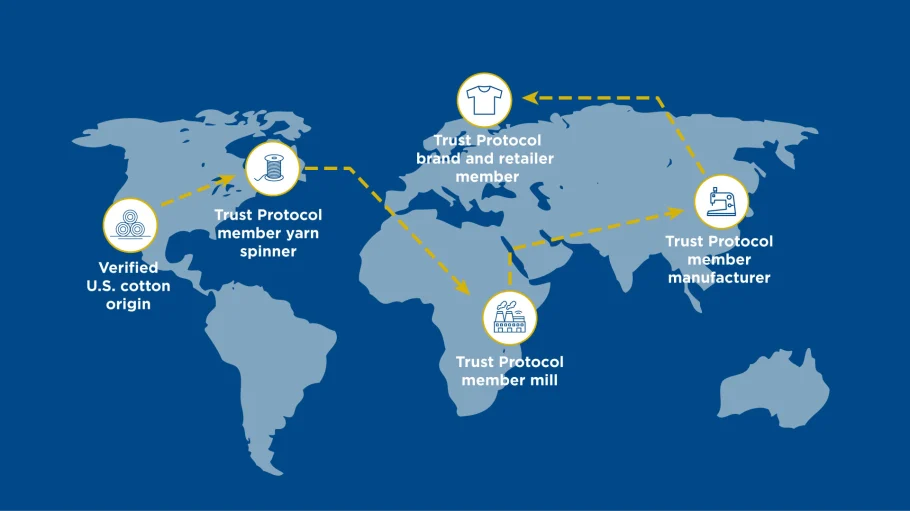Brands and retailers are seeking solutions that retool and reimagine visibility as they simultaneously scramble to tighten the links of their supply chains. And for the U.S. Cotton Trust Protocol, its latest offering is centered on refining said supply chains through its namesake fiber, all in the name of transparency.
The Trust Protocol, launched in October 2020, is dedicated to improving U.S. cotton production by exclusively offering measurable, verified data for brands, retailers, and its broader stakeholders. Its members have access to year-over-year statistics that ensure the cotton fiber in their supply chains is sustainably produced and with low environmental risk, as the Trust Protocol tracks metrics for U.S. cotton such as water use, greenhouse gas emissions, soil loss, soil carbon and energy use.

And now, the organization offers unrivaled transparency with the introduction of its Protocol Consumption Management Solution that captures the movement of Protocol Cotton fiber as it flows through brand and retailer members’ supply chains.
Here, the Trust Protocol talks to Fairchild Studio about its new solution, collaboration with TextileGenesis™, and what’s coming up next.
Fairchild Studio: Tell us about the Protocol Consumption Management Solution (PCMS). What is unique about its tracking system for cotton?
The PCMS is harnessing the power of blockchain and other digital technologies to deliver an unparalleled level of visibility and transaction verification across the supply chain. This makes the U.S. Cotton Trust Protocol the world’s first sustainable cotton fiber program to offer its members article-level transparency across the supply chain and the ability to connect the valuable environmental data more directly that we are capturing from participating grower members’ farms to their products.
Unlike any other solution before, the PCMS is capturing transactions at the individual article level, which allows us to maintain a robust inventory ledger of Protocol-eligible materials at each stage and provide our brand and retail members an added level of assurance of the Protocol Cotton consumed in their products.
Fairchild Studio: What led to a partnership with TextileGenesis™ for this initiative?
Recognizing the growing importance of increased supply chain visibility to brand and retailer members, the Trust Protocol announced a collaboration with TextileGenesis™ in April to offer its members article-level transparency throughout the supply chain.
In combination with the existing Trust Protocol Platform, the TextileGenesis™ platform will allow the PCMS to record and verify the movement of U.S. cotton fiber through the entire process by capturing and verifying article-level transactions between the multiple participants along the complete supply chain.
Upon receipt of their finished products, Trust Protocol brand and retail members will be able to claim Protocol Cotton Consumption Units, digital tokens equivalent to the physical cotton produced under the program, and make corresponding claims related to the environmental metrics and sustainable practices adopted by participating Trust Protocol grower members.
Fairchild Studio: How do Protocol Cotton Consumption Units enable gathering of environmental data for brands and retailers?
As the brand and retailer members receive digital confirmation of their Protocol-eligible finished product, the PCMS will calculate the amount of kilograms of Protocol Cotton fiber that was consumed throughout the process, considering waste factors along the way, into a specific number of digital Protocol Cotton Consumption Units which are then available for brands and retailers to claim.
When the brand or retailer receives the Protocol Cotton Consumption Units, a proportional amount of the aggregated farm-level environmental data captured by the Trust Protocol can be assigned to that brand or retailer member, enabling them to make their own sustainability claims and report against their science-based targets.
By providing this insight, the Trust Protocol offers brands and retailers two scarce assets in sustainability: quantifiable, verifiable data and a fully transparent supply chain.
Fairchild Studio: What else do brands and retailers need to know about the Protocol Consumption Management Solution? Are there any success stories to share?
The Trust Protocol data collection starts with the grower who voluntarily provides farm-level information via the 120-question self-assessment questionnaire on their sustainable production practices in soil health, tillage operations, water use, and pesticide management, among others. After harvest, grower members will complete their field assessment using an online tool developed by Field to Market.
The PCMS begins when the grower member’s cotton is ginned and each unique Permanent Bale Identification number is attached. At this point, the exact gin weight is known and an exact amount of Protocol Cotton Consumption Units are created, where one Protocol Cotton Consumption Unit is created for each kilogram of Protocol Verified Cotton. In an era when fiber origin is of utmost importance, the PBI information related to the shipments of U.S. cotton fiber by merchandisers to yarn mills are being captured in the Protocol Platform and verified against the USDA database.
The PCMS will create a transparency map that provides the authenticated origin of the U.S. cotton, along with the names and locations of the Trust Protocol mill members that were involved in all parts of the production process, into the finished products that are shipped to the brand or retailer.
Initial pilot trials were conducted with five brands and retailers beginning mid-2021, with full deployment of the PCMS envisioned for early 2022.
Fairchild Studio: What’s next for U.S. Cotton Trust Protocol?
The Trust Protocol was created to set a new standard in more sustainable cotton, and we are proud of the significant achievements made in the program’s first year. Our goals are rooted in the idea that U.S. cotton production can contribute to the protection and preservation of the planet by using sustainable and responsible growing techniques.
In the last month, the Trust Protocol published its inaugural Annual Report, which provides an in-depth overview of how the program came into and how it is aiding the U.S. cotton industry in advancing its sustainability performance in key environmental metrics. In its first year, the Trust Protocol has made significant strides with over 560 supply chain members, 950,000 bales of cotton enrolled in the program, and major brand and retailer members including Gap Inc., Levi Strauss, and Co. and PVH Corp.
The program is bringing quantifiable and verifiable goals and measurement to the key sustainability metrics of U.S. cotton production — enabling continuous improvement across the supply chain.
Πηγή: wwd.com

